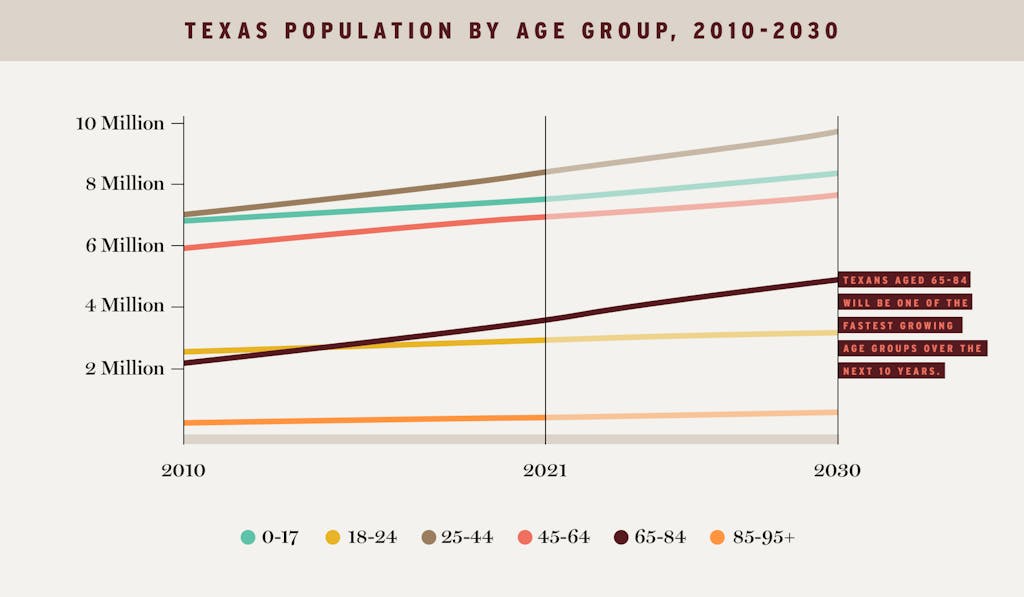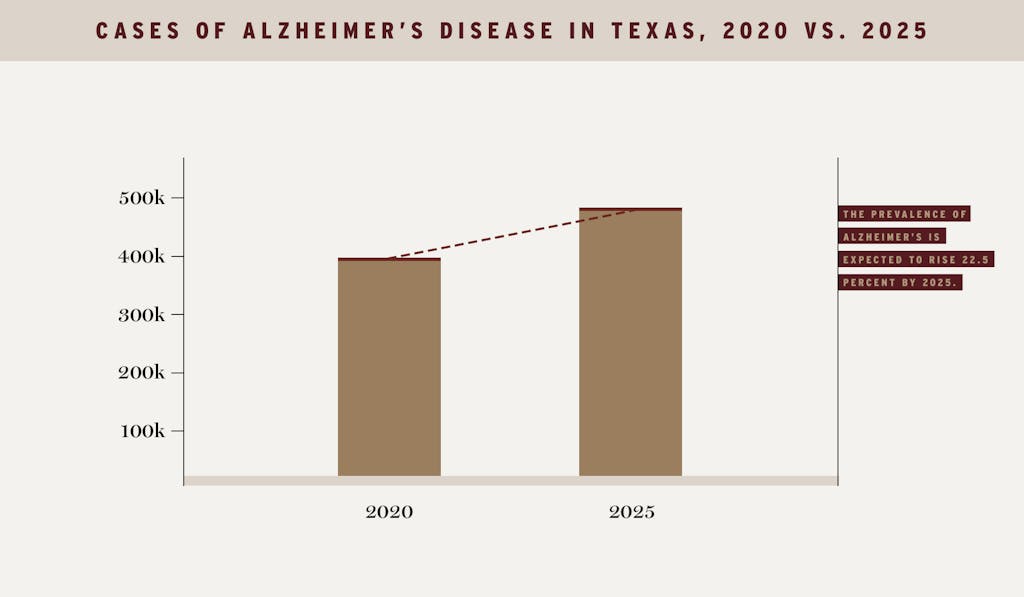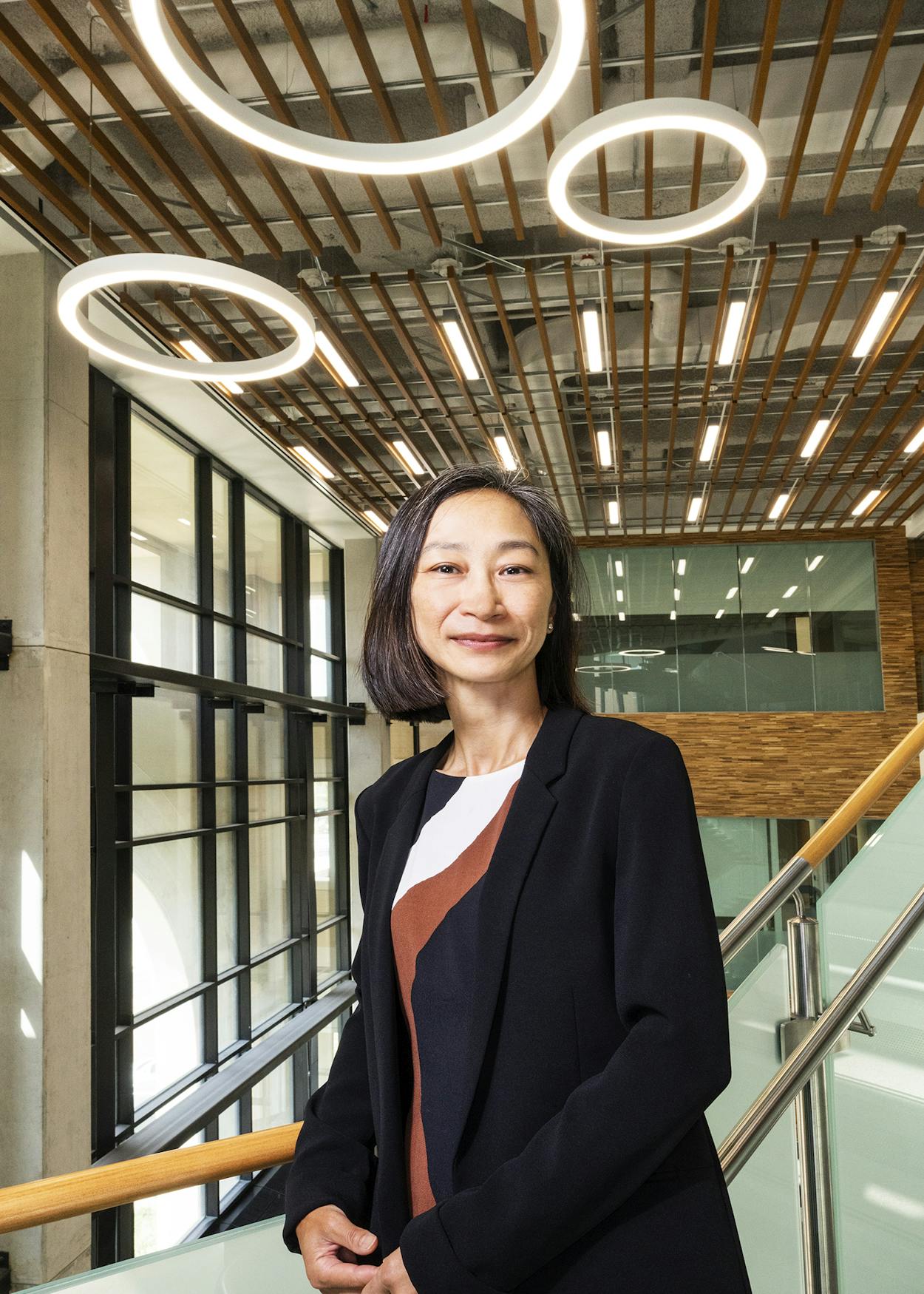Everyone wants to live as safely, happily, and independently as possible—and how that looks changes as we age. Texas State University interior design professor Mira Ahn, Ph.D., has made aging in place her teaching and research focus, resulting in crucial insights for nations facing a coming tsunami of seniors as well as individuals planning for their own or a loved one’s elder years.
“It’s all about life satisfaction,” Dr. Ahn says. “But it’s not an easy journey to uncover the important factors that matter for older adults’ quality of life.”
The graying of America is an indisputable demographic wave that is sharply increasing demand for better and more options in geriatric healthcare, in-home caregiving, and assisted living facilities. In 2030, when all baby boomers will be 65 or older, senior Americans will make up 21 percent of the population—up from 15 percent in 2019. In Texas, more than 20 percent will be over age 60 by 2030, according to the U.S. Census Bureau.
Professor and program coordinator for Interior Design in Texas State University’s School of Family and Consumer Sciences, Dr. Ahn is also an integral member of the university’s Alliance of Researchers in Aging (ARIA), which is affiliated with the University’s groundbreaking Master of Science in Dementia and Aging Studies Program (MSDA).
The first of its kind in the U.S., the Texas State MSDA online program mission encourages students to take a global, interdisciplinary, and human rights perspective in order to create compassion and understanding for elders and persons with dementia. Graduates are prepared to enter dementia- and aging-related careers in extended-living setting management, patient advocacy, health education, or cutting-edge research, all while empowering caregivers and encouraging autonomy for elders and persons with dementia.
“The MSDA program is a unique interdisciplinary program in that it is the only gerontology program in the nation with a focus on dementia studies,” says Kyong Hee Chee, Ph.D., Texas State professor of sociology and graduate program coordinator for MSDA. “I am especially proud of our graduates and students—many of them are already working in the field of dementia and elder care.”
Dr. Ahn sees population trends as an invitation for individuals nearing their elder years, along with their families and caregivers, to seek current and emerging ways to optimize quality of life, regardless of age, by contemplating myriad factors including social connection, optimally designed interiors, technology, nutrition, and transportation.

Dr. Ahn began her research with simple questions of what aging in place means: Is it phenomenon, preference, goal, or process? Then she wanted to explore its value. Is it always desirable in American society? She notes that aging in place is not something rigidly defined as a person staying in the same home where they’ve lived for many years, but rather as an individual finding where to age in the right place for them, which may change as their needs change. A good environmental fit also takes into account community qualities like transportation and opportunities for social interaction, one of the key factors in determining quality of life.
“Collaborating with experts in different areas, such as lighting, sleeping, or health insurance, helps me move to a next step in setting up new research goals,” she says, noting that at Texas State, she has appreciated opportunities to work with colleagues like Asha Hegde, Ph.D., a professor in the Interior Design program and a renowned lighting expert.
“Aging in place is complicated, and as new generations reach their oldest years, we will have different expectations about home and its meanings.”
Dr. Ahn has received multiple teaching awards and recognition for her published research, which focuses on topics like understanding the concept of aging in place, how to support aging in place well, and the influence of perceived home environment on home modifications. The self-effacing and thoughtful academic has put much consideration into the ways that aging individuals can utilize technology—ranging from low-tech wearable pendants that enable seniors to put out a call for emergency help at the push of a button, on up to smart homes and even robots.
“I see great potential of information technologies in assisting older adults’ aging in the right place, especially with technologies incorporated into residential settings, such as with smart homes or smart cities,” Dr. Ahn says, adding the caveat that some older adults who aren’t familiar with information technologies or have increasing cognitive impairments might find sophisticated technology difficult to navigate.
For those elders, resources and manipulations from people or the physical environment need to be more focused, such as encouraging home modifications and providing accessible, simplified channels in getting needed help and services. “These resources should be used to prevent a stuck-in-place situation where aging in a current place would hurt an older person’s quality of life,” she says.
Dr. Ahn joined Texas State in 2008 on a path that began in her home country of Korea, where she earned her bachelor’s and master’s degrees in statistics and architectural design, respectively. She also conducted research related to housing planning and residential space design for the Korea National Housing Corporation. From there, she earned her doctorate at Virginia Tech, with a dissertation that illustrates her professional leanings: “Older People’s Attitudes Toward Residential Technology: The Role of Technology in Aging in Place.”
But Dr. Ahn’s perspective reaches beyond technology. “My focus is on people, their near environments of house and neighborhood, and their behavior and perceptions as a result of interactions with these environments,” she says. “Aging in place is complicated, and as new generations reach their oldest years, we will have different expectations about home and its meanings.”
Our behavior is a function of an interaction between a person, their capabilities, and the environment, she adds. “If you’re having a limitation with daily activities, like walking around or bathing, and the house is exactly the same and nothing changes, that could be a problem,” she says.
Dr. Ahn’s focus on the environmental and psychological impacts on older adults’ behavior and well-being made her a natural candidate for Texas State’s cross-department ARIA group and brought her attention to the university’s master’s program.
ARIA brings together academicians to better collaborate in this challenging field. Dr. Chee started organizing the ARIA a couple of years ago, and currently has fifteen members from eight different departments/schools across the university, including the School of Family and Consumer Sciences.

“Dr. Ahn and I have talked about collaborating on the topic of aging in place for persons living with dementia,” Dr. Chee says. “We’ll bring together our different disciplinary perspectives and knowledge to propose an ideal physical and social context in which persons with dementia could remain socially active, enjoying their previous lifestyles as much as possible.”
Dr. Ahn’s classes have undergraduates thinking ahead about the considerations of aging. For college juniors, Dr. Ahn assigns the project of designing a multi-generational home that enables extended families to live under one roof, with quality spaces that enable shared interaction, respect everyone’s privacy, and incorporate a barrier-free ground floor for residents’ current and future needs as they age.
The multifaceted assignment includes researching the concept and considerations of multi-generational living, following design and space requirements, and developing a concept and study model as well as schematic and final designs, such as colors and textures of wall and flooring surfaces. For example, people tend to lose their ability to judge depth as they age, so high-contrast and bright colors help them distinguish walls, door frames, and other interior features from one another, improving navigation and orientation. Blues and greens are relaxing and comforting colors for interior spaces, but aging eyes are not likely to process these two colors well, reading grey. So bright colors in warm tones are recommended instead. Slip-resistant flooring surfaces like textured, honed flooring or low-pile carpet and a maximum quarter-inch level change make environments safer.
Successful aging in place extends beyond a home’s walls to the surrounding area. People often need help from others in their families or communities, and need to be in a place, socially and physically, where that’s possible. “For those who are healthy and capable of doing daily activities, alternative housing types would be an option, such as shared housing, a multi-generational home, or a village model,” Dr. Ahn says. Some obvious benefits from these types of living are providing more opportunities for family and social interaction for residents, which is a critical factor for older persons’ quality of life.
“The most important factor in quality of life is social connectedness.”
A village model provides many elements of this community support and socialization. “The most important factor in quality of life is social connectedness,” says Dr. Ahn, noting that it ranks ahead of health, finances, and nutrition. The village model sets up older adults (ages 50-plus) for successfully aging-in-community by allowing the members to help each other and share local resources. Beacon Hill Village, the first model in the U.S., was established in Boston in 2001.
“I think this aging-in-community model depicts the most natural thus sustainable way of aging well, especially in urban areas,” says Dr. Ahn. “We also need to find what works in areas that lack resources, namely people and infrastructure.”
The analysis of quality of life needs diverse perspectives and ongoing study, she adds. The demand for these solutions only continues to grow as our population ages, and Texas State’s first-of-its-kind program is poised to help make a difference in how we design our lives.
“These components are interrelated like puzzle pieces, and are also multi-layered,” Dr. Ahn adds. “As an aging-in-place researcher, I believe we are making progress.”









